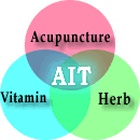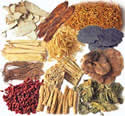Chinese
herb
Flos
Carthami (Hong Hua£¬ºì»¨)
Source
The flower of Carthamus tinctorius L., family Compositae.
Characteristics
Flower fine, elongated-striped, or several strips jointed together,
1.0-1.5 cm long. Corolla red or orange-red, tubular, 5-lobed at
the upper part, lobes linear; each corolla containing 5 stamens;
anthers yellow, gathering into tubes; stigma of pistil stretching
from the anther tube, and 2-forked. Slightly aromatic in odour.
Acrid in taste, warm in nature, and attributive to heart and liver
channels.
Indication
1. Promote blood circulation to remove blood stasis, promote menstruation
and alleviate pain: For blood-stasis syndrome with amenia, dysmenorrhea,
or postpartum abdominal pain. Recently, for ischemic apoplexy, angina
pectoris, thromboanglitis obliterans, sudden deafness, sclerederma
neonatorum, flat wart, neurodermatitis, etc.
2. Promote blood circulation to relieve carbuncle: For preventing
and treating bed sore (extemal use); for conjunctivitis and the
early stage of the carbuncle.
3. Promote blood circulation and let out the skin eruption: For
blood stasis with impediment of skin eruptions.
Pharmacological Action
1. Its decoction stimulates uteri and intestines of experimental
animals in vitro.
2. Its decoction increases coronary flow and lowers blood pressure
in dogs.
3. Small dose of its decoction mildly stimulates and large dose
inhibits the heart of toads.
Administration Decoction:
0.6-1.0g for promoting blood production; 2.0-2.5g for regulating
blood; 3-9g promoting blood circulation; 9-12g for removing blood
stasis.
Injection: 50% solution 2-4 ml IM once or twice daily; for ischemic
apolexy, 10-15 ml added in 10% glucose 250 ml IV for drips daily,
15-20 times as 1 course.
Radix
et Rhizoma Rhei(DaHuang,
´ó»Æ)
Source
The root and rhizome of Rheum palmatum L, R. tanguticum Maxim.
ex Balf. or R. officinale Baill., family Polygonaceae.
Characteristics
Crude drug nearly terete, conical or lecotropal, 5-15 cm long,
2-8 cm in diameter; surface yellow-brown, sometimes with residual
cork. Prepared
as transversely cut pieces. The section of rhizome showing narrow
cortex and wood, broad pith with altemating yellow-brown and red-brown
striae and numerous peculiar vascular bundles in asteriate annular
arrangement or scattered; the section of the root showing developed
xylem, radially arranged vascular bundles and visible annular
marks. Delicately aromatic in odour. Bitter in taste, cold in
nature, and attributive to spleen, stomach, large intestine, liver
and pericardium channels.
Indication
1. Promote digestion and relieve dyspepsia, purge heat and clear
away toxic materials:
(1) for constipation of sthenia-heat type with coma, delirium,
convulsion, mania or abdominal distension and pain, usually used
together with Natni Sulfas, Fructus Aurantli Immaturus, Cortex
Magnoliae Officinalis, (Decoction for Potent Purgation);
(2) for syndrome resulting from evils accumulating in the thorax
with abdominal distension and pain, tendemess, dry tongue and
thirst, hectic fever, or shortness of breath and restlessness,
used together with Radix Euphorbiae Kansui, Natni Sulfas (Decoction
for Severe Phlegm-Heat Syndrome in the Chest);
(3) for acute appendicitis, usually used together with Cbrtex
Moutan Radicis, Semen Persicae;
(4) for dysentery of dampness-heat type with abdominal pain and
tenesmus, used together with Fructus Aurantii Immaturus, Rhizoma
Co ptidis, etc;
(5) Single use for biliary infection, cholelithiasis and pancreatitis;
for biliary ascariasis used with Herba Artemisiae Scopariae together;
(6) for acute and simple intestinal obstruction, roundworm intestinal
obstruction and paralytic intestinal obstruction, Decoction for
Potent Purgation may be used;
(7) for food and drug poisoning;
(8) for pulmonary heart disease with respiratory failure and constipation;
(9) for uremia, decoction as enema may be used;
(10) for cold-syndrome with constipation, used together with Radix
A coniti Praeparata, Rhizoma Zingiberis, etc.
2. Clear away heat and toxic materials: Oral and external use
for furuncle and carbuncle due to intense heat; topical use for
bum of medium or small size, cervical erosion and mycotic vaginitis;
for furunclosis complicated by septicemia, used together with
Flos Lonicerae, Fructus Forsythiae, etc.; also for sorethmat,
conjunctival congestion, aphthae and toothache due to domination
of fire.
3. Stop bleeding: For peptic ulcer with bleeding, also for hemoptysis
and epistaxis due to blood stasis, blood-heat or domination of
fire; external use for traumatic bleeding.
4. Promote blood circulation and remove blood stasis: For trauma,
especially those of the chest and abdomen with constipation; amenia,
dysmenorrhea and postpartum abdominal pain due to blood stasis.
5. Chologogue and relieve jaundice: For preventing and treating
icterus neonatorum (including ABO type hemolytic jaundice of newborn),
used together with Herba Artemisiae Scopariae, Radix Scutellariae,
Radix Glycyrrhizae; for icteric viral jaundice, and acute and
serious cases of hepatitis.
Pharmacological Action
1. Sennoside A is the component for purgation.
2. Promoting biliary secretion and enhancing the amount of bilirubin
and bile acid.
3. Rhein and Emodin exert bacteriostatic effect by inhibiting
the synthesis of DNA, RNA and protein in bacteria.
4. Eniodin is a component for hypotensive.
5. Oral use of its extract reduces the ratio of serum cholesterol
and total phospholipid in rabbits with hypercholesterolemia.
6. Chrysophanol, an other active component, exerts a hemostatic
effect.
Administration Decoction: 3-12g. Powder: 2-5g, daily dose 4-10g.
For purgation, decoct later (only boil for 15 minutes) or soak
in the boiled water for oral use.
Back
1
2 3 4 Next

